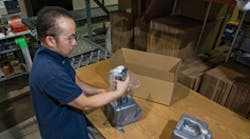As the demand for remanufactured parts increased, so did the customers’ demand that these parts match their original condition in quality. That was a challenge because the more people who worked in this remanufacturing process, the wider the variance in quality.
The answer to this problem lay in lean.
Four years ago Parts Now moved into a new facility and the vice president of operations implemented a 5S program (sorting, straightening, shining, standardizing and sustaining), incorporating many of the lean principles he had picked up in his career. The program was incorporated into a cellular manufacturing concept in which, instead of individual technicians working on one re-furb at a time, now teams of 3 or 4 people each handle a specific step in the re-manufacturing process (cleaning, rebuilding, inspecting and packaging). Lead times on high volume parts went from 2 to 3 days to 15 minutes.
The new building has a circular manufacturing flow with raw material, inventory and printer cores on the outside of the circle working their way to the middle through the process. In the end the circle flow allows the product to exit from the same inbound loading doors.
The packaging portion of these operations uses on-demand, J-I-T foam packaging molding equipment (Sealed-Air’s Instapak iMold system). Prior to this, molded foam packaging consisted of a “wet bag” system which contributed to the long cycle time. Operators would set a bag in a box, wait for it to foam up and grow, set the product in the box and let the foam come up around it. They would then get another bag, lay it on top of the product, hold the box flaps closed and allow the material to continue foaming up. Some workers would put too much foam in and break the part.
The iMold process added consistency to the forming of molded foam cushions and contributed to more of an OEM look and feel, according to Matt Olson, an industrial engineer in Parts Now’s inventory management, scheduling and ordering department.
“When customers get the product it looks like something that came from HP,” he says. “It also makes the customer more comfortable getting a remanufactured product. In three years transitioning from 100% foam-in-place to 75% of our remanufactured products getting some form of pre-molded end cap, we were able to reduce the amount of foam we used by 88,000 pounds, translating to $181,000 over that three year period. Now packaging can package all our products on the same day they’re produced and get them moving right into stock. Packaging is consistent every time. Four kinds of product use the same box. The only thing that changes is the end cap inside.”
Overall, Parts Now’s cellular production operation saves $60,000 a year, thanks to using two fewer employees to produce the same number of fusers. It also went from producing 800 units a day to 900 without resorting to overtime.
“We can produce 1,000 a day when peak demand hits during school’s start and at tax time,” Olson concludes.



